Nancy Moser's Blog, page 8
July 21, 2011
The Trip of a Lifetime
[image error] The Moser gang at VersaillesI've been absent from this blog for a few weeks, but I have a good excuse. My husband and I took our three grown children and their spouses to Europe for the trip of a lifetime. We were not disappointed. Before we left, we made it clear to the kids (ages 26-33) this was not going to be a vacation, but an excursion. On the road by 7:30 most mornings we shared the glories of Rome, Florence, Venice, Lucerne, Paris, and London. But even more than that, we shared time.
[image error] St. Peter's in RomeAway from the duties of our lives back home, we concentrated on each other. We oohed and ahhed at the majesty of the Sistine Chapel and Versailles, shared laughter as we had a picnic in the grass at the base of the Eiffel Tower on Bastille Day, and marveled at an impromptu Swiss oompa band practicing above a sidewalk cafe in Lucerne as we ate bratwurst.
[image error] Eiffel Tower in Paris
Together we marveled at God's handiwork from our vantage point on top of the Alps at Mt. Pilatus, and at man's ingenuity as we took a fast train under the English channel from Paris to London.
[image error] The Roman Colosseum
We were humbled by history as we saw the tomb of St. Peter, the Roman Colosseum, the actual armor of Henry VIII, and the stunning St. Paul's Cathedral in London where I remember watching Princess Diana get married back when I was a young mother . . .
[image error] On the top of the Alps
in SwitzerlandI've been to Europe over a dozen times, but during each trip the history dazzles me and makes me marvel at the course of humankind. And so, over the next few weeks I'm going to share some of those amazing tidbits of history with you. Not necessarily the big moments in time regarding kingdoms and dynasties, but the personal stories of actual people who lived and struggled, who won and lost. People who, but for a century or two (and a few thousand miles), shared many of the same feelings and life challenges that we face today. Theirs are the stories that remained with us as we moved from country to country.
[image error]Marie Antoinette and her childrenOne such story was brought to our attention through a portrait hanging in the French palace of Versailles. It was a painting of Marie Antoinette and her three children--the last portrait painted of her. Marie was originally named Maria Antonia. She was the youngest daughter of Empress Maria Theresa of Austria, and was married off to Louis XVI of France at the age of fourteen... The shy Maria and the her young husband (only fifteen himself) took years to consummate their marriage. Their lack of a child was the gossip of the continent. People--from royal to the lowest man on the street--knew their personal business and offered opinions. Maria was a naive girl who had not been groomed to be a queen. It took eight years for her to conceive.
Adding to my interest of her, was the revelation that this Marie Antoinette was the same girl I'd written about in my bio-novel Mozart's Sister. As a child Maria Antonia had heard the young Mozart and his sister Nannerl give a recital in her family's palace in Vienna. When five-year-old Wolfgang tripped during the concert, Maria helped him to his feet. The impulsive little Wolfgang kissed her, said he was going to marry her, and then had the gall to climb into the lap of Maria's mother, the empress. That girl was this woman...
At Versailles, as I stood with my own family beside me and looked upon this grown up Maria Antonia--Marie Antoinette--I learned of another family's trip, taken in an attempt to flee France during the chaos and danger of the French Revolution. As the masses of the suffering poor rose up against the decadence of the ruling class, Marie's world of luxury crumbled around her. So she and her husband the king fled with their three children, hoping to escape to monarchy-friendly Montmédy in northeast France. But before they could find freedom they were caught and returned to Paris. All were imprisoned, and Marie and Louis were eventually beheaded by the mobs who demanded satisfaction.
But what of the children in the painting? There is an empty cradle in the background that sorrowfully represents Marie's youngest daughter Sophie who had died during the painting of the portrait, just before her first birthday. The oldest daughter, Marie Therese, standing at her mother's right, was exiled to Austria. She married but was childless. The little boy, Louie Joseph--the heir--died of TB during the tumulutuous political times, and the baby on her mother's lap (Louie Charles) died in prison. And so the Bourbon line of France was destroyed.
Seeing this painting, hearing this story, walking beside my own husband and children, I felt compassion for this queen. This woman. This mother.
It would not be the last time I would count my blessings on this trip . . .
July 17, 2011
A Most Unsuitable Match
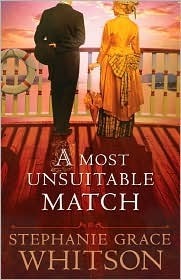
With great joy, I'd like to announce my new release, A Most Unsuitable Match.
The story idea was inspired by visiting a historical site in Nebraska as part of my master's degree program. http://www.fws.gov/midwest/desoto/bertrand.htm. The steamboat Bertrand sank in 1865 with more than 250 tons of cargo aboard. Rediscovered (in a field--the Missouri River changed course a lot back then!) in 1968, the cargo was salvaged and is now on display.
When I learned that sisters ages 19 and 17 were on board and saw one of their coats on display (see it on the right), I knew I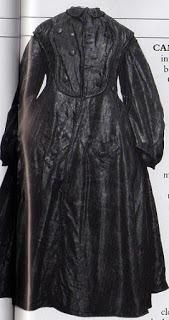 wanted to tell a story about a young woman's adventure traveling north on the Missouri.
wanted to tell a story about a young woman's adventure traveling north on the Missouri.A Most Unsuitable Match follows Fannie Rousseau upriver in 1869 in search of her last living relative. Fannie is from a privileged family and has never encountered 'rustic' living. On her journey she meets Samuel Beck, who is headed upriver in search of his run-away sister. Fannie and Samuel are very different people … except in how they can't seem to stop thinking about each other.
Today I thought I'd invite you to come and play with my imaginary friend, Fannie Rousseau, of St. Charles, Missouri, as I interview her aboard the steamboat Delores on the second day of the two-thousand-plus mile journey north to Fort Benton, Montana.
Miss Rousseau, tell me the most interesting thing about you.
Interesting? I'm not all that different from any other young lady raised to be … just that. A lady. I suppose some would think it interesting that I've embarked on this journey. To tell you the truth, I thought it was interesting and brave--until the Delores pulled
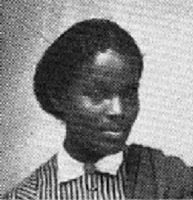 away from the levee yesterday. Now I'm thinking it may be the stupidest thing I've ever done. But I'm here now. At least I have Hannah with me. She thinks travelling by steamer is like flying, it's so fast. Seeing her excited about the trip helps some. I just hope I don't live to regret running off like this.
away from the levee yesterday. Now I'm thinking it may be the stupidest thing I've ever done. But I'm here now. At least I have Hannah with me. She thinks travelling by steamer is like flying, it's so fast. Seeing her excited about the trip helps some. I just hope I don't live to regret running off like this.
What do you do for fun?
I haven't had fun in a while. I've been in mourning since Mother died a few weeks ago.
What are you afraid of most in life?
Being alone. That's why I'm here, you know. I'm going to find my Aunt Edith. Two days ago I didn't even know I had an Aunt Edith. Can you imagine that? A girl my age growing up without knowing her own mother had a twin sister?
What do you want out of life?
I just want to understand why. Why didn't Mother tell me about Aunt Edith? Why did Mr. Vandekamp—he's in charge of Papa's affairs—why did he get so angry when I asked him about her? He forbad me to come on this trip. I let him know that I am of age and he cannot forbid me to do anything. I want answers, and I'm going to find them.Thankfully, Hannah agreed to come with me. I don't know what I'd do without her.
Do you read? If so, what is your favorite type of book to read?
Oh, I just love Mr. Dickens! Don't you? I can read his books over and over again and they never grow old.
If you could change one thing about yoursel f, what would it be?
I'd be more … sure. Of who I am. Of what I should become. I'd be able to look back and accept things without feeling so … lost.
Do you have a pet? If so, what is it and why that pet?
Mother didn't allow pets. She said they were an unnecessary nuisance. I used to pretend that Minette's dog, Jake, was mine. They just live next door. Minette's my best friend. She was happy to share Jake.
If you could travel back in time, where would you go and why?
I'd visit the place Mother grew up in France. Maybe if I saw her as a girl, I'd finally understand … well. That's silly, isn't it. the past isn't going to reveal itself. Unless I force the issue. That's what I'm hoping this trip will do for me. Reveal the past, and help me find a future.
____________________________________________________________

Read the beginning of A Most Unsuitable Match here:
http://www.bethanyhous e.com/ME2/Audiences/dirmod.asp?
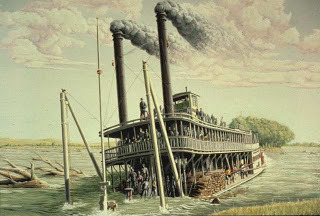
--Stephanie Grace Whitson
July 10, 2011
Remember the Ladies
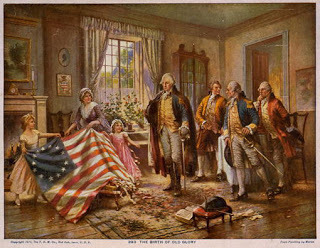 As I celebrated the Fourth of July this past weekend (at the Mississippi Valley Blues Festival on the banks of the Mississippi River in Davenport, IA), the usual swell of patriotism and thankfulness had me thanking God for the great blessing of being an American. But then, as I thought about blogging today (thanks, Tracie, for inviting me), Abigail Adams's words came
As I celebrated the Fourth of July this past weekend (at the Mississippi Valley Blues Festival on the banks of the Mississippi River in Davenport, IA), the usual swell of patriotism and thankfulness had me thanking God for the great blessing of being an American. But then, as I thought about blogging today (thanks, Tracie, for inviting me), Abigail Adams's words came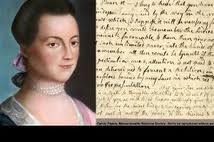 back to me. In a letter to her husband, John, in March of 1776, Abigail wrote, "I long to hear that you have declared an independency. And, by the way, in the new code of laws which I suppose it will be necessary for you to make, I desire you would
remember the ladies
and be more generous and favorable to them than your ancestors.
back to me. In a letter to her husband, John, in March of 1776, Abigail wrote, "I long to hear that you have declared an independency. And, by the way, in the new code of laws which I suppose it will be necessary for you to make, I desire you would
remember the ladies
and be more generous and favorable to them than your ancestors. "Remembering the ladies" is a large part of what many women writers do when we create our characters. We remember—and celebrate—the uniqueness that is woman.
I've been working on my master's degree in history, and I think that, by now, the word is out that professors c
an expect Stephanie to always have something to say about the women. But, honestly…too many history texts don't remember the ladies! Just last week an intensive class on the Bill of Rights made the point that the Constitutional Convention ended up taking months, and that meant that the men involved were away from home for months. The emphasis was on their sacrifice … my thoughts were of the women back home running the farms and family businesses while their husbands were away.
When Abigail wrote John, he and his cohorts were fleshing out a certain document that, when they signed it the following July, would change history for us all. I love the obvious affection that resonates in John's reply to Abigail's request. " … your letter was the first intimation that another tribe, more numerous and powerful than all the rest, were grown discontented." (He had no idea!) He goes on to write, "Depend upon it, we know better than to repeal our masculine systems," and adds further that "in practice, you know we are the subjects." He further teases Abigail about the "despotism of the petticoat."
Here's to the historians and novelists who answer Abigail Adams's call to "remember the ladies."
 Recent reads of mine introduced me to Martha Washington via Nancy Moser's Lady Washington; southern girls during the Great Depression in Elizabeth Musser'sThe Sweetest Thing and Judith Miller's Amana women in A Place to Belong. My new release A Most Unsuitable Match takes a well-to-do young woman to the end of a steamboat journey and, consequently, to the end of herself in Fort Benton, Montana.
Recent reads of mine introduced me to Martha Washington via Nancy Moser's Lady Washington; southern girls during the Great Depression in Elizabeth Musser'sThe Sweetest Thing and Judith Miller's Amana women in A Place to Belong. My new release A Most Unsuitable Match takes a well-to-do young woman to the end of a steamboat journey and, consequently, to the end of herself in Fort Benton, Montana. Remember the ladies!!!!
---posted by Stephanie
June 23, 2011
Sports Women

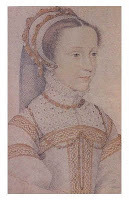 Mary Stuart,
Mary Stuart, Queen of Scots Up until the late nineteenth century, if you were a woman you were not allowed to participate in sports. When did it change?
There were always the exceptions. Women in ancient Greece were not allowed in the Olympics, so they held their own Games of Hera every four years. Mary, Queen of Scots was an avid golfer, and called her assistants "cadets". The first caddies. During her reign (1542-67), the famous golf course of St. Andrews was built. Women in Regency times walked—Elizabeth Bennet in Pride & Prejudice enjoyed a good, hardy stroll. There have been a few boxers, fisher-women, horse racers, runners, hot-air balloonists, and archers.
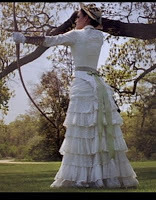 May in "Age of Innocence"But until the 1870's to 1890's mainstream women and sports didn't mix.
May in "Age of Innocence"But until the 1870's to 1890's mainstream women and sports didn't mix.
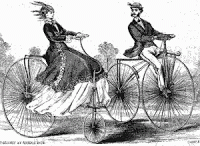
The bicycle changed everything—though not because it was a way to get exercise or that it was considered a sport, but that it finally allowed women autonomy. They could move quickly from Point A to Point B by themselves. And they didn't need a man to come along as a chaperone. I think about the feeling of freedom a woman would have felt the first time she rode a bicycle. The breeze through her hair, the exhilaration of using her limbs until they burned… And the choice involved to go somewhere. Even that. Especially that. Choice.
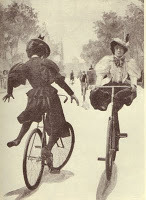 As bicycles gained popularity in the 1880's, women's clothing was adapted for ease of movement. No more bustles! As early as 1850 Amelia Bloomer developed "bloomers" to wear under a skirt, thus giving women more freedom of movement. With bicycles, the bloomers were ends in themselves. How risque! Some considered women who rode bicycles whores... Yet in the decade of 1890-1900 over a million women would ride bicycles. Beyond all the other sports, bicycling was a wide-spread hit.
As bicycles gained popularity in the 1880's, women's clothing was adapted for ease of movement. No more bustles! As early as 1850 Amelia Bloomer developed "bloomers" to wear under a skirt, thus giving women more freedom of movement. With bicycles, the bloomers were ends in themselves. How risque! Some considered women who rode bicycles whores... Yet in the decade of 1890-1900 over a million women would ride bicycles. Beyond all the other sports, bicycling was a wide-spread hit.
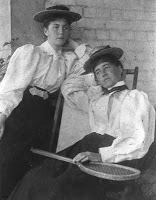
During this time many sports became womanized: rowing, hiking, fencing, lawn tennis, tennis, croquet, sailing, and swimming. The summer resort of Newport, Rhode Island, encouraged all these activities. I have some of my characters deal with bicycling, swimming, and sailing in An Unlikely Suitor. Even baseball was played by women: According to this wonderful timeline site, in 1875 two women's teams, the "Blondes" and "Brunettes", played their first match. "Newspapers heralded the event as the 'first game of baseball ever played in public for gate money between feminine ball-tossers.'"
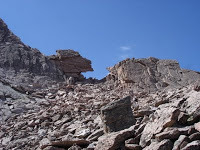 Boulder Field of Long's Peak Some of these sports didn't require a lot of physical effort, but some did. In 1871 Addie Alexander climbed Longs Peak in Colorado. I've climbed Long's Peak (the tallest peak in Rocky Mountain National Park at 14,256 feet), but I was 18 and wearing rubber-soled shoes. I can't imagine climbing over the Boulder Field in the slippery leather-bottomed shoes of Addie's time. Twenty-two years later, Katharine Lee Bates climbed Pike's Peak and composed a poem, "America the Beautiful." It was set to music in 1910 by Samuel A. Ward. On top of the peak, there is a commemoration plaque.
Boulder Field of Long's Peak Some of these sports didn't require a lot of physical effort, but some did. In 1871 Addie Alexander climbed Longs Peak in Colorado. I've climbed Long's Peak (the tallest peak in Rocky Mountain National Park at 14,256 feet), but I was 18 and wearing rubber-soled shoes. I can't imagine climbing over the Boulder Field in the slippery leather-bottomed shoes of Addie's time. Twenty-two years later, Katharine Lee Bates climbed Pike's Peak and composed a poem, "America the Beautiful." It was set to music in 1910 by Samuel A. Ward. On top of the peak, there is a commemoration plaque.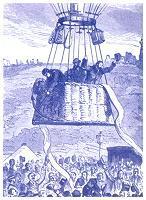 With the doors to sports open, some women took it to extremes. In 1891 Mary French Sheldon led an expedition to East Africa. That same year Beatrice Von Dressden jumped with a parachute from a hot air balloon. This was her first jump. First? Are you kidding me? She did it again? Get this woman a place on "Fear Factor"!
With the doors to sports open, some women took it to extremes. In 1891 Mary French Sheldon led an expedition to East Africa. That same year Beatrice Von Dressden jumped with a parachute from a hot air balloon. This was her first jump. First? Are you kidding me? She did it again? Get this woman a place on "Fear Factor"!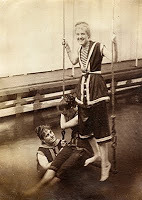 Not everyone thought women should exert themselves and there were many articles condemning this change in women's lives. Many men seemed intimidated by a strong, active woman. But in 1892, the YMCA devoted an issue to women, saying exercise for women was a good thing.
Not everyone thought women should exert themselves and there were many articles condemning this change in women's lives. Many men seemed intimidated by a strong, active woman. But in 1892, the YMCA devoted an issue to women, saying exercise for women was a good thing.Maybe so, but that doesn't mean I have to like it! And as with most acts of freedom, I appreciate having the choice.//Nancy
June 19, 2011
1903 , Kuna, Idaho, and Donna Fletcher Crow's Daughters of Courage Series
It's Monday, and I (Stephanie) can't think of a better way to begin a week than with a great story combined with a good deal.
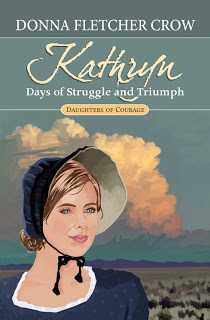 Donna Fletcher Crow (www.DonnaFletcherCrow) joins us today to share footnotes from Idaho history (inspired by her own family heritage), with news of a re-release of her beloved Daughters of Courage series.
Donna Fletcher Crow (www.DonnaFletcherCrow) joins us today to share footnotes from Idaho history (inspired by her own family heritage), with news of a re-release of her beloved Daughters of Courage series. The "good deal" part is for those of you with ereaders, because Greenbrier has made the books available for a short time for ... can you believe it ... less than one dollar each. Happy Monday, booklovers! (Kindle: http://ning.it/kqmEE1 Nook: http://ning.it/lruv7t ).
I suppose I should admit right away that two of my favorite reasons for loving Kathryn's story include the Scotsman (I'm part Scot) and the character named Stephanie (ahem). Lenore Persons of Guideposts Books said this after reading Kathryn: It's rare to find novels that combine a strong Christian ethic with such compelling story-telling. Because these are real people and real events, the experiences of faith challenged and faith triumphant are all the more meaningful. I hope that Donna Fletcher Crow's loving testament to her grandmother and mother and to the brave men and women who shaped our country will touch you as much as it did me.
The story's main character,Kathryn, has never been short on courage. But then she's never faced a wilderness so hot and dry that the only growing thing is endless miles of rattlesnake-infested sagebrush with the nearest fresh water 15 miles away. Yet Kathryn Jayne is determined not merely to survive. She will thrive. Even when those nearest to her die. Even when murder strikes their tiny community. Even when a dashing, irreverent Scotsman struggling to outdistance a troubled past brings turmoil to Kathryn's heart.
From untamed Idaho, to Edwardian London, to enchanting Scotland, Kathryn records her experiences in the journals that become an inspiration for her family and the basis for this gripping saga.Through every generation America's women have exhibited courage, spirit and faith. Kathryn, Elizabeth and Stephanie are true Daughters of Courage. This sweeping family saga will help today's women find inspiration to triumph in the challenges we all face.
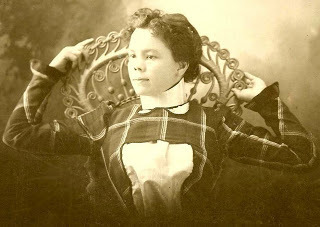
Let's talk about the history behind this series. You mentioned a family photograph?
Even as a child I loved this picture of my paternal grandmother Esther Fletcher when she was a teenager. She was so pretty. And I loved her dress. Could my grandmother ever have been that young?
I have always been able to look at a picture from history and put myself in that scene, so when my editor askedme to write a pioneer series, I knew I wanted to tell my grandmother's story.
What was the most surprising thing you learned about "the real story" while researching this book?
Well, okay. I didn't immediately want to tell my grandmother's story. I didn't want to do a pioneer story at all. Jeanette Oke was all the rage at that time. And there was the wonderful Little House on the Prairie series. One more tree didn't need to die for another pioneer story.
Then I began researching the lives of my grandmothers and other Idaho pioneer women— and I discovered that our desert pioneers had completely different stories from the sod buster stories we all think of when we say pioneer romance.
These incredible women who homesteaded in the desert before the irrigation canals were dug in 1909 had to survive a climate so dry that washing wrung out by hand and spread on a sagebrush bush at night would be dry in 20 minutes. After Indian Creek dried up in June the nearest water was 15 miles away in the Snake River and had to be carted up in a horse-drawn buckboard. And the only creatures who could survive in the wild were jackrabbits and flying ants that would swarm down the stovepipe in the heat of the day. Then fall dead on the floor when soot encrusted their bodies.
And yet these brave women not only survived their days, but would also sit down at night and write in their journals. These journals have been collected in the Kuna Library where I did a great deal of my research and I used Kathryn's journal as a through-line in my series as a source of strength for her daughter and granddaughter.
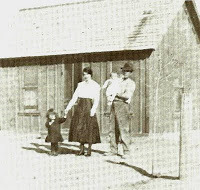 Besides the photograph of my grandmother which I mentioned above, the photographs, such as this one on the left, of pioneer families standing proudly in front of their homesteads inspired me with a sense of the courage and vision they must have had. Surely they were seeing "the desert blossom as a rose" in their minds. Look hard and you'll see a heartbreakingly fragile tree planted beside the house.
Besides the photograph of my grandmother which I mentioned above, the photographs, such as this one on the left, of pioneer families standing proudly in front of their homesteads inspired me with a sense of the courage and vision they must have had. Surely they were seeing "the desert blossom as a rose" in their minds. Look hard and you'll see a heartbreakingly fragile tree planted beside the house.
One book that really helped my research was titled THE SETTLEMENT OF THE KUNA REGION 1900-1925 (sponsored by: Kuna Joint School District No. 3, Kuna Library District, and the Association for the Humanities in Idaho, and dedicated to the memory of Warren Reynolds who was a moving force in the Kuna History Project). Warren Reynolds must have been a distant cousin of mine, because Reynolds is a family name on my mother's side. The book was helpful for its narrative, but even more so for its many, many pictures like this one.
What spiritual encouragement did you draw from what you've learned?
Every generation has its own unique challenges that require its sons and daughters to stand strong, but God is always faithful. I find it encouraging to know that no matter how hard things might seem today, and no matter how dim the flame of faith might flicker, it has been much harder and the flame has burned much lower in other times, but it has always come back. At times only a handful have stood against a dark, but, with God's help, it has been enough.
Did you meet a special woman from the past you'd like to tell about?
Kathryn is a composite of both of my grandmothers Esther Smith Fletcher and Tennie Botner Book. Although I have very dear childhood memories of both of these courageous women (they were both at our wedding, even) I felt that I came to know them in a new way by recreating the world they raised their families in. A world so different from our own that required skills and knowledge none of us have today.
___________________________________________________
Special thanks to Donna for joining us today... learn more about her and her stories at:
www.DonnaFletcherCrow.com (AND DO GO HERE...I think Donna has the most intriguing author photo I've ever seen. Makes me want to tag along on her next research trip!)
www.donnafletchercrow.com/articles.php
June 16, 2011
Feeding Baby
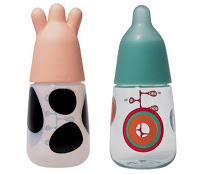 We are expecting our fourth grandchild this fall. It's made me wonder about what kind of bottle this child will be using. I am amazed at all the different options out there, from the tradition bottle, to ones that are bent at an angle, to those with disposable innards, etc. Will the formula be with iron, lactose free, take two scoops or four?
We are expecting our fourth grandchild this fall. It's made me wonder about what kind of bottle this child will be using. I am amazed at all the different options out there, from the tradition bottle, to ones that are bent at an angle, to those with disposable innards, etc. Will the formula be with iron, lactose free, take two scoops or four?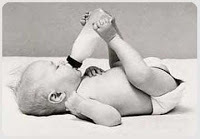 When I was writing my novel, Masquerade, which was set in 1886, I had to do some research about bottles and milk. Was milk available for purchase in the poorer areas of New York City? And what did bottles look like?
When I was writing my novel, Masquerade, which was set in 1886, I had to do some research about bottles and milk. Was milk available for purchase in the poorer areas of New York City? And what did bottles look like?Turns out the issue of getting milk into a baby—when the mother couldn't nurse—has always been an issue. In medieval times, babies drank from a hollowed out horn. Later on, there were "pap feeders" made of porcelain. And "pap" was often boiled water and flour. Sometimes bread or egg was added.
In the mid-1800's cow's milk was shipped in wood barrels and would easily spoil. It was a dairy farmer by the name of Gail Borden who did something about it. He was sailing home to the USA from Europe, when they encountered rough seas. The cows on the ship got seasick and wouldn't make milk—I never imaged that was possible. The babies on board were crying from lack of milk. Personally, when I look at situations like this, the odds of getting a dairy farmer with foresight on a ship in a storm, with cows that couldn't produce milk . . . it leads me to know that the entire situation was God-arranged.
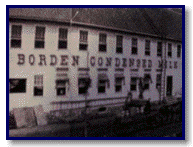 When Borden got home he started doing experiments with milk and found that it was 87% water. If he boiled it down in an airtight pan, he came up with a condensed version that was resistant to spoilage. On the way to Washington D.C. to get a patent, he met up with a wealthy grocery wholesaler, and together they canned it and tried to sell it. In 1864, the Eagle Brand Consolidated Milk company was formed.
When Borden got home he started doing experiments with milk and found that it was 87% water. If he boiled it down in an airtight pan, he came up with a condensed version that was resistant to spoilage. On the way to Washington D.C. to get a patent, he met up with a wealthy grocery wholesaler, and together they canned it and tried to sell it. In 1864, the Eagle Brand Consolidated Milk company was formed.Canned milk was not a huge success. During production, essential fats and nutrients were lost, and people were used to a more watery consistency and a white color (to get the white color, chalk used to be used!) But Borden persevered, and the Civil War was a boon to his business as the troops were sent condensed milk as part of their rations. At one point during the war, Borden produced 300,000 gallons of condensed milk at his Elgin, Illinois plant. It seems that this milk was not a beverage, but just a condensed form of the milk product.
In 1885, John Meyenberg, an immigrant from Switzerland, was producing the first evaporated milk at his Helvetica Milk Condensing Company plant. Soon after, Eldrige Amos Stuart developed a way to process canned, sterilized evaporated milk. By the end of the century, he partnered with Meyenberg and supplied Klondike gold miners milk in 16 ounce cans.
As the twentieth century began, homogenization was implemented, and in 1934, Meyenberg's company (now the Pet Milk Company) added Vitamin D to their evaporated milk by a process called irradiation. He exposed the milk to ultraviolet light, which created the vitamin (amazing!)
So… canned milk was available for purchase. But what then? How did you feed it to the baby?
Ceramic or porcelain bottles were used in the 19th century, with a piece of cloth or rawhide stuffed into the end for the baby to suck upon. Preserved cow udders were also used. (yuck!) But these containers were hard to keep clean. Bottles became a little more sanitary when glass blowers began to create actual bottles for this use.
In the 1840's vulcanized rubber came about that made rubber nipples possible. But the smell was horrible, and they were not widely manufactured.
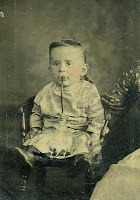 In the 1880's a type of bottle was created that was advertised as the way to feed your baby. Once the craze caught on, everyone and their brother had their own version of this bottle. It was marketed by many names including "Mummies Darling" and "The Princess Alexandria" (she was the Princess of Wales at the time and was very popular.) But in spite of the marketing, this bottle was a baby killer.
In the 1880's a type of bottle was created that was advertised as the way to feed your baby. Once the craze caught on, everyone and their brother had their own version of this bottle. It was marketed by many names including "Mummies Darling" and "The Princess Alexandria" (she was the Princess of Wales at the time and was very popular.) But in spite of the marketing, this bottle was a baby killer.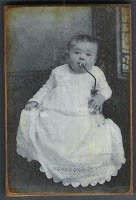
It consisted of a glass tube that held the milk, that had a stopper on it. A length of rubber tubing went from bottle to a bone mouth shield, and a rubber nipple. The big advantage was that the baby could feed themselves, even before they could hold a bottle. The disadvantage was it was impossible to keep clean and children died. Considering only two out of ten children lived to age two, mostly because of hygiene issues, this type of bottle was a horrendous addition to a continuing problem. Even though doctors preached against it, this type of bottle was used into the 1920's. It's impossible to measure how many babies died because of the germs formed and left behind in these bottles.
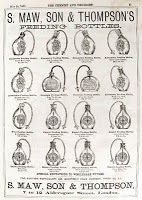
Look at these photographs of babies using these bottles. How odd looking. And more than that, how odd that the parents would let a precious photograph be taken with their baby sucking on one of these. It would be like having a formal picture of your child with a pacifier in its mouth. That first picture of the little boy . . . he looks drugged.
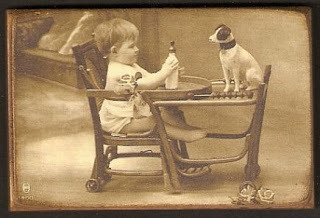
1894 brought a breakthrough that carried the bottle into the 1950's. A "double-ended" feeder invented by Allen and Hanbury. It was glass and had a nipple on one end and a valve on the other that allowed the milk to flow continually—and made a full cleaning possible.
 I was born in 1954 and my bottles were also glass and the usual procedure was for mothers to sanitize the bottles and nipples in boiling water. Then came plastic bottles, and when we fed our three kids (in the late 1970's to mid-1980's) I used the Platex nurser ("Most like mother herself"), that had the disposable bags. When the grandbabies came along, I was rather surprised to find that the disposable method had been re-replaced with plastic again.Here's a baby bottle museum site It's said that whatever's old is new again, but hopefully, never again with certain baby bottles of the past.//Nancy
I was born in 1954 and my bottles were also glass and the usual procedure was for mothers to sanitize the bottles and nipples in boiling water. Then came plastic bottles, and when we fed our three kids (in the late 1970's to mid-1980's) I used the Platex nurser ("Most like mother herself"), that had the disposable bags. When the grandbabies came along, I was rather surprised to find that the disposable method had been re-replaced with plastic again.Here's a baby bottle museum site It's said that whatever's old is new again, but hopefully, never again with certain baby bottles of the past.//NancyJune 9, 2011
Trains, Boats . .. and NO Automobiles
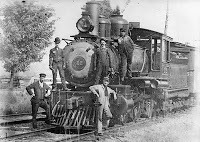 It's 1895. Look at a map. If you were rich and lived in New York City and wanted to go to Newport, Rhode Island for the six-week summer season, how did you travel those 175 miles?
It's 1895. Look at a map. If you were rich and lived in New York City and wanted to go to Newport, Rhode Island for the six-week summer season, how did you travel those 175 miles?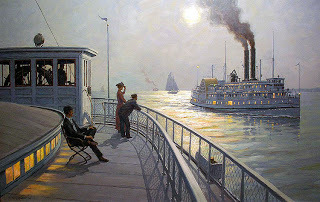
Cars hadn't been invented yet. And considering Newport was on an island... You had two choices: take the train or take a steamer ship.
When I was doing the research for An Unlikely Suitor, this transportation issue was my biggest challenge. It's not like there are that many train schedules sitting around from 1895. And as an additional complication, the character who needed to go on the journey was a poor seamstress, not someone from the Vanderbilt set.
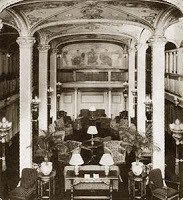 Interior of Fall RIver Line Steamer
Interior of Fall RIver Line Steamer
I discovered that most wealthy travelers took steamers. The Fall River line left from the North River in NYC in the evenings so its passengers slept on the ship and stopped in Newport, continuing to Fall River, Massachusetts, then continuing on to Boston, where businessmen could be at work in the morning.
The interior of these steamers was luxurious. They had staterooms, or there were berths in dorm-type rooms. Even middle class passengers could experience a bit of luxury on such a ship.
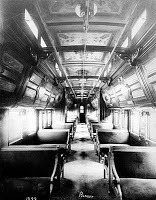 2nd class car
2nd class carOthers went on the train from Grand Central Station (see my June 2 blog) to Wickford Junction, Rhode Island, where they'd take a short trek down to the dock to catch a steamer for the 75 minute trip to Newport. On the trains, the second class cars were simple seats and had a shared lavatory for both men and women.
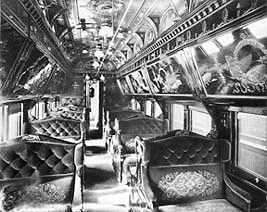 This is the train car I used in An Unlikely Suitor
This is the train car I used in An Unlikely SuitorFirst class train travel was more luxurious, with velvet seats, and gilded ceilings. There were salon cars and dining cars.
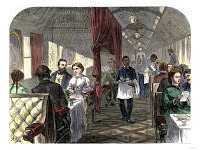 1869 Dining Car
1869 Dining CarBut… it still must have been a hot and noisy ride as men wore suits and women wore long-sleeved, high-necked ensembles. And hats and gloves. A few years ago I was riding in a train in France that lost its air conditioning, and it was a miserable experience—and I was dressed for the heat. So first class or no, travel could be tedious.
 1895 Fashion
1895 Fashion When the wealthy set arrived in Newport, they would find that their summer homes were ready for them, as their servants had been sent ahead weeks earlier. And each socialite had ordered at least thirty new outfits for the 6-8 week season. Summer vacation was a big production for all involved.
Sometimes I imagine being able to take one of these ladies in my car and explain to her the highway system, rest stops, drive through food, cruise control, reclining seats, climate settings, cup holders (and 44 oz. drinks), navigation systems, back-up cameras, the radio, CDs, and DVDs. They'd probably scream from the speed alone...
But wouldn't it be fun to share?//Nancy
June 5, 2011
1881 Arizona & Mary Connealy, Author of Deep Trouble
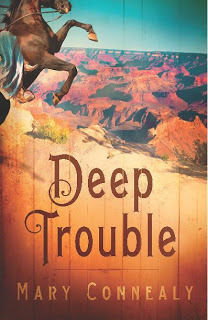
Today I've asked fellow Nebraska author (yeah!) Mary Connealy to tell us about what it's like to be in deep trouble :-). I just retrieved my copy from my daughter, who gave it applause and a "thumbs up."
Deep Trouble follows Shannon Dysart on a search for a city of gold, the lost city of Quivera, which she believes is in the bottom of the Grand Canyon. She's on a quest to prove her father's research isn't the work of a madman, and that he really did find treasure in the west.
Gabe Lasley is trying to keep her alive until she comes to her senses ... and then he plans on marrying her. With trouble on their back trail from the villains who still want Shannon's map, the dream of gold coloring every decision Shannon makes, and Gabe's surprising need to protect her, they set out to find a city of gold. Along the way they find that true treasure is rooted in love. And that was within their reach all along.
What artifact, place, histor
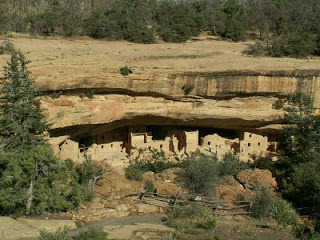 ical event, or woman from history made you want to write this book?
ical event, or woman from history made you want to write this book? Deep Trouble really began as a treasure hunt. X marks the spot, you know??? My heroine is searching for the Seven Cities of Gold, the Kingdom of Quivera. As I tried to figure out where in the world a city of gold might be hidden, I latched on to a long ago memory of a visit to the Grand Canyon. If someone wanted to really hide something, where better. My heroine's course is set and then the trouble begins. Deep Trouble.
What was the most surprising thing you learned about "the real story" while researching this book?
I did a lot of research about the history of the Grand Canyon and found out there were a lot of people, very early on who recognized it as a tourist treasure. It's so remote it's hard to believe someone would think travelers would come there, but Americans, even back then, had a great knack for figuring out how to profit from their hard work. The research I did about the Seven Cities of God struck me as being a mythological heaven on earth. Streets of gold. It made a wonderful contrast between the heroine looking for earthly wealth and the hero trying to get her to accept what was truly treasure here on earth. Love, family, faith.
Is there a historical photograph that inspired you you'd like to share?
My book begins in Mesa Verde, in Colorado. I slightly fictionalized Mesa Verde and didn't exactly pin point the location because I needed my cliff dwellings to be of a very specific design so someone could be trapped at the topmost cave simply by removing a ladder and Mesa Verde didn't do that for me, from what I could see in pictures. I've attached a picture of Mesa Verde to my email and if you'll look close there could be some caves high above the others, and if I was searching for gold in that place, I'd probably find a way to look in every nook and cranny.
What one non-fiction book helped you research the most (for those who want to learn more)?
For the Grand Canyon I relied heavily on The Man Who Walked Through Time by Colin Fletcher. Colin Fletcher is the first man to walk the length of the Grand Canyon. His first person reactions to the canyon were invaluable to me.
What spiritual encouragement did you draw from what you've learned?
Writing this book made me want to get out into nature. I spend so much of my life behind the computer researching. I'm trying to get out more, go to museums, visit locations, get my hands on things. It deepened my respect for the beauty God has created all around us and what a beautiful country we've been blessed with.
VISIT MARY AT:
www.maryconnealy.comwww.mconnealy.blogspot.comwww.seekerville.netwww.petticoatsandpistols.com
June 2, 2011
Grand Central Station
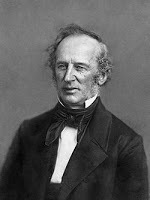 You've probably heard of the "Commodore" in regard to American history. He—Cornelius Vanderbilt—was the founding father of the Vanderbilt dynasty in the mid-1800's. He began earning his fortune in steam shipping, and expanded to railroads. He was ruthless, and became one of the richest men in America. When he died in 1877 he left $100 million--$95 million to one son and his four sons, and $2 million each to a grandson and two other sons, and a piddling $250,000-$500,000 each to his eight daughters. One "wastrel" son, Cornelius, got a $200,000 trust fund. He considered the one lucky son--William Henry Vanderbilt--the only one capable of continuing his business. And even the ones who received the lesser amounts were considered wealthy for it.
You've probably heard of the "Commodore" in regard to American history. He—Cornelius Vanderbilt—was the founding father of the Vanderbilt dynasty in the mid-1800's. He began earning his fortune in steam shipping, and expanded to railroads. He was ruthless, and became one of the richest men in America. When he died in 1877 he left $100 million--$95 million to one son and his four sons, and $2 million each to a grandson and two other sons, and a piddling $250,000-$500,000 each to his eight daughters. One "wastrel" son, Cornelius, got a $200,000 trust fund. He considered the one lucky son--William Henry Vanderbilt--the only one capable of continuing his business. And even the ones who received the lesser amounts were considered wealthy for it. 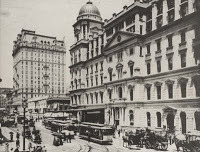 Grand Central from Lexington 1890
Grand Central from Lexington 1890But enough about the Commodore's wealth, and back to railforads... In New York City, Vanderbilt bought the key land between 42nd & 48th Street, Lexington to Madison, with the intent of constructing a new train depot. In 1871, at a cost of $6.4 million, the first Grand Central would arise—and be out of date even before it opened. Why?
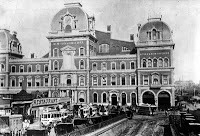
It was the time of the Industrial Revolution, and times were changing. Constantly. Even as the Commodore had the Grand Central depot built, the steam engine—for which it was built—was on its way out. Steam engines were noisy, dirty, and potentially dangerous—and one arrived every 45 seconds!
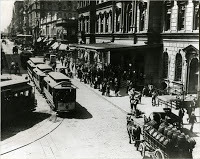 Streetcars arriving at Grand Central
Streetcars arriving at Grand Central In 1902 there was a collision in the smoke-filled Park Avenue Tunnel that killed 17 and injured 38 people. This catastrophe fueled the demand for the cleaner electric trains. By the end of 1902 there were plans to demolish GSS and build a double-level terminal. Isn't that the way? It takes the loss of life to get our attention, and get much-needed changes implemented. Here are some original news articles about it: Grand Central 1902 crash
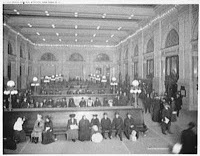 Interior 1880's? This is what I used
Interior 1880's? This is what I usedin my novel An Unlikely Suitor
Another negative about the design was its congestion. Originally the GSS served three rail lines—that each had its own facilities for waiting, baggage, and ticketing. Talk about confusing! The New York Central and Hudson River Railroad, New York and Harlem Railroad, and the New York, New Haven, and Hartford Railroad, all shared the space.
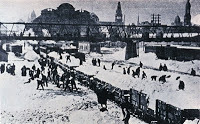 Clearing the tracks after Blizzard of 1888Although updated in 1899, in 1913 the GSS that we know now was unveiled, and 150,000 people attended the ceremonies. The 1930's and 40's were the heyday of train travel. "In 1947, more than 65 million people -- the equivalent of 40% of the U.S. population -- traveled through Grand Central Terminal."
Clearing the tracks after Blizzard of 1888Although updated in 1899, in 1913 the GSS that we know now was unveiled, and 150,000 people attended the ceremonies. The 1930's and 40's were the heyday of train travel. "In 1947, more than 65 million people -- the equivalent of 40% of the U.S. population -- traveled through Grand Central Terminal." 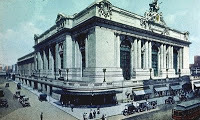 New Grand Central about 1918
New Grand Central about 1918 But then . . . during the Fifties . . . people started to drive and fly and train travel waned. GSS was nearly demolished to make way for more of the skyscrapers that surround it. But concerned citizens rallied (including Jackie Kennedy Onassis) and the original 1913 station was preserved—and restored. Today it houses many restaurants and shops and gives us a glimpse of the past. //Nancy
 Restored Grand Central terminal today
Restored Grand Central terminal todayHere is a great website about the Grand Central Station, with some interesting "secrets" and trivia: Grand Central Station Info
Some famous movies filmed there: "North by Northwest", "The Cotton Club", "The Fisher King", "Superman"… and wasn't there a scene in "The Prince of Tides" filmed there? With the kid playing his violin? Grand Cental Movies
May 31, 2011
Quilts and the Sod House Experience
Thanks for putting up with the announcement! I've been working on the talk instead of writing a blog post.....and proof-reading the galleys for my next book ..... and proof-reading a commentary on Philippians by my pastor .... and I'm overwhelmed! ----Stephanie



